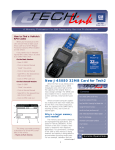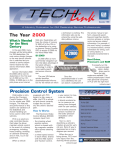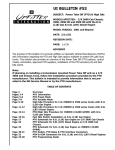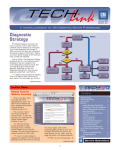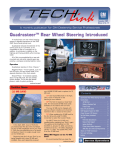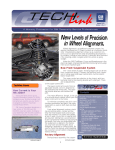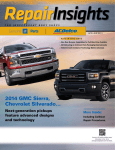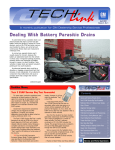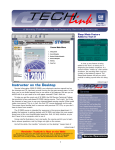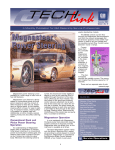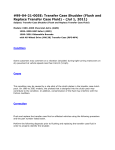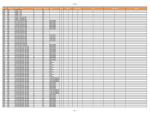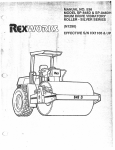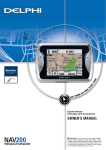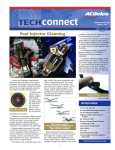Download Service Information of the Future is Here Now
Transcript
October 1999 A Monthly Publication for GM Dealership Service Professionals Service Information of the Future is Here Now Add the number 2000 to the end of any name and you've got a hightech, futuristic sounding product. But now that the year 2000 is actually upon us, what does that number really mean? Service Information 2000 will be released to GM dealerships across the country later this year. And in this case, 2000 does stand for hightech. While Service Information 2000 is sent to dealerships on five CDROMs, that same service information can be found on the World Wide Web. Service Information on the Welcome Back The only thing constant is change. That can be applied to just about anything in life. But we at Tech Link are back, and looking forward to bringing you more service information to help you do your job. We have made a number of changes to your service magazine as well. New features are being added and will appear in the coming months. We'll give you the news about Techline and other service information support systems in the dealership. More of the latest service Web provides access to the same GM service information you've come to look for in the paper manuals and on CD. Service Information 2000 and Service Information on the Web include all 2000 model year service information along with the newly redesigned 2001 Aurora, in addition to bulletins and campaign information released since 1980. If you're thinking Service Information 2000 simply replaces Electronic Service Information (ESI) with more CDs, think again. Service Information 2000 does replace the ESI CDs, but does it all with only a information about current product issues will be coming from the Technical Assistance Center. We'll explain the way things work regarding new components and systems in addition to a look back to some basic theories of operation. You'll find a review of new service bulletins so that you can keep up on the latest information. And there will be plenty of details about new product, so you'll know what's coming to your dealership and be able to better understand and explain those features to your customers. Our focus is to pro- vide those in the dealership service department -- service managers, technicians and service consultants -- with timely information to help increase knowledge about GM products and improve the performance of the service department. We're here to help you, so if you're looking for more information about a particular topic, or have a question about a service issue, let us know. Feel free to contact us by phone, mail or E-mail using the listing on page 2. few CDs. The software for navigating and displaying service information in Service Information 2000 is written in Java, a computer language that allows the information to be condensed onto fewer CDs while providing easier navigation to the information. continued on page 2 Table of Content Service Information of the Future is Here Now . . . . .1 TIS 2000 Update . . . . . . . . . . . . . . . . . . . . . . . . .3 Service Information Hits the Web . . . . . . . . . . . . . .3 2000: What's News . . . . . . . . . . . . . . . . . . . . . . .4 Warranty Parts Return . . . . . . . . . . . . . . . . . . . . .5 New Diagnostic Starting Point . . . . . . . . . . . . . . . .5 Smart EVA . . . . . . . . . . . . . . . . . . . . . . . . . . . . . .6 Terminal Repair Kit . . . . . . . . . . . . . . . . . . . . . . . .7 Bulletins . . . . . . . . . . . . . . . . . . . . . . . . . . . . . . . .8 It's good to be back. -- Mark Stesney 1 Service Operations Just One Click through each service manual section. The service information found on Service Information 2000 CDs and on Service Information on the Web is organized by the same service manu- When viewing information after completing a search, menu bar buttons allow for zooming in and out to magnify a schematic or diagram so it’s easier to read. Easy Access SI 2000 main menu al sections as in the paper manuals. The difference is the navigation through the information. From the main menu, the year, make and model as well as many particular vehicle systems can be selected. Next, the section of the service manual can be selected, and then the subsection of the manual. Previously, looking up this information would require either one or two clicks of the mouse depending on the information you wanted to select. Now, it’s all one click. So it’s not necessary to double click to select one section and then single click for another. Service Information 2000 can be downloaded onto a stand-alone personal computer (PC) right in the service bay. Some of the computer hardware minimum requirements to run the software include 32 Meg of RAM and a 3.5 GB hard drive. More information about system requirements and setup about Service Information 2000 will be sent to dealerships shortly. Future updates of service information will be sent on one CD to dealerships periodically. Dealerships will need to update PCs with the latest service information. The navigation of Service Information 2000 is very user friendly, and the Help menu provides assistance in finding information. User guides will be included with the There are navigation buttons at the top of the main menu for both service manual information and unit repair manual information, bulletins and campaigns, and the latest updated service information. SI 2000 service manual page By clicking the latest information icon, you can review the service information that has been updated with a new CD release or satellite broadcast. This allows you to quickly keep up to date on new service information without searching release of the application to dealerships. Although Service Information 2000 is high-tech, it’s technology put to use to make your job easier. 2 GM Tech Link is a monthly magazine for all GM retail technicians and service consultants. This magazine is a companion to the GM Edge publication. Publisher: Gracemary Allen VSSM Communications Executive Editor: Mark Stesney GM Service Operations [email protected] Technical Editors: Mark Spencer [email protected] 1-248-816-3647 Jim Horner [email protected] 1-248-816-3641 FAX number: 1-248-649-5465 Write to: Tech Link PO Box 500 Troy, MI 48007-0500 Desktop Publishing: Greg Szpaichler, MediaWurks.com General Motors service tips are intended for use by professional technicians, not a "do-it-yourselfer." They are written to inform those technicians of conditions that may occur on some vehicles, or to provide information that could assist in the proper service of a vehicle. Properly trained technicians have the equipment, tools, safety instructions and know-how to do a job properly and safely. If a condition is described, do not assume that the bulletin applies to your vehicle or that your vehicle will have that condition. See a General Motors dealer servicing your brand of General Motors vehicle for information on whether your vehicle may benefit from the information. Inclusion in this publication is not necessarily an endorsement of the individual or the company. Copyright© 1999 General Motors Corporation All rights reserved. TIS 2000 Update The Techline Information System (TIS) 2000 application periodically receives updates through GM ACCESS broadcasts that add to the capability of the system. The latest broadcast in October to the GM ACCESS file server in GM dealerships included several enhancements to the TIS 2000 application. These enhancements are designed to make TIS 2000 more efficient and effective. Many of these changes are transparent to the user and affect only the internal operation of the application; however, there are several changes that provide additional functionality to the TIS 2000 application. TIS 2000 is the group of several software programs that perform Service Programming (SPS), Tech 1 and Tech 2 updating, and Tech 1 and Tech 2 snapshot uploading and analysis. With the latest GM ACCESS broadcast, a Pass-Thru feature is now available with the Service Programming System to update the flash calibration files that are stored in a vehicle’s onboard control module. Pass-Thru allows you to connect the personal computer (PC) in the service bay to the vehicle using the Tech 2 as a communications interface. Previously, it was necessary to separately connect the Tech 2 to the vehicle to obtain information from the control module and to the PC in order to download a new calibration file. Now, to use the Pass-Thru function, select Pass-Thru under Select Diagnostic Tool in the Service Programming System. Enter the required vehicle information and then follow the screen instructions on the PC for connecting the Tech 2 to the vehicle and the PC. Make sure that the Tech 2 is on the Tech 2 title screen. The Tech 2 allows the vehicle control module to communicate with the PC and a new calibration file is downloaded straight to the control module in a few, easy steps. Keep in mind that the RS232 cable used with the Tech 2 may lose its communication capacity once the distance between the vehicle and the PC approach approximately 50 feet or more. Another new feature of TIS 2000 is its new graphing function under Snapshot display. Up to six parameters from a snapshot can now be displayed in one graph on the PC. Parameters are selected in the same manner as in the previously available three-graph display. Simply click on the Display Graph icon, then click the first graph icon at the top of the graph parameters window and select a parameter from the list. Click the other graph icons to select additional parameters. When six parameters are selected, click OK, and they will all be displayed on a single graph with each parameter being colorcoded. Use the navigation icons or click and drag on the arrow along the bottom of the graph to move through the parameters in the graph. New TIS 2000 user guides will be shipped to dealerships shortly. Consult the new guides for additional information about the capabilities of TIS 2000. -- Mark Spencer 3 Service Information Hits the Web As Service Information 2000 is released, more and more dealerships also will have access to Service Information on the Web. And it’s just that: service information on the World Wide Web. The web site is currently in the pilot stage at a number of GM dealerships. To search and use the service information, dealerships need to have access to the Web through an Internet Service Provider (ISP), a modem connection or a dedicated line for an Internet connection, and a Web browser -Netscape 4.5 or Internet Explorer 4.0 or higher -to view Web sites. The service information is the same as that found on Service Information 2000 CDs. And the navigation through the information is nearly identical. Yet, there are a few enhancements. Since it is a Web site, there is E-mail communication available to the Techline Customer Support Center (TCSC), whether it’s for an answer to a question about navigation or to report an error in the service information. TCSC will acknowledge the Email, and provide a response. 2000: What's News What's the big news for the 2000 model year? From cars to trucks, sedans to sport utilities, plenty of new models and updates to current models are coming. In the months ahead, we’ll take a closer look at many of the new features and systems available on the 2000 model year vehicles. Here's a quick list of some of the changes being made to GM’s lineup for 2000. manifold design. The fuel system pressure also has been increased 27 percent for more reliable hot starting. Cadillac The DeVille is an allnew model for 2000. Also based on the G-body platform, the car has a number of high-tech features. Buick Introduced as an early 2000 model, the LeSabre is an all-new car based on the G-body platform. The new structure provides a solid foundation for an improved ride, handling and steering. New safety features include standard side air bags for the driver and front passenger, Catcher's Mitt front seats that help protect occupants in a low-speed rear impact and the optional Stabilitrak integrated vehicle stability control system. The Century’s 3.1L V6 engine receives enhancements that help the engine pump out 15 more horsepower, now up to 175 hp, and 10 more pound-feet of torque, now 195 ft.-lbs. This additional power is due to the new combustion chamber and intake to determine whether or not to enable the front and side passenger air bags. The seat sensor measures the weight as well as the posterior impression in the seat to distinguish a child from a lightweight adult. An indicator in the rear-view mirror tells the driver if the passenger air bags are turned on. ver’s side of extended cab models. Chevrolet Oldsmobile The all-new Impala and Monte Carlo are based on the W-body. Both models offer the 3.4L V6 engine or the 3.8L V6 engine. The Alero offers the new Getrag 5-speed manual transmission on models with the 2.4L L4 engine. The 2.4L L4 engine has been dropped from the Malibu. Malibu is now available only with the These include the thermal imaging Night Vision System for improved vision down the road while driving at night, the Ultrasonic Rear Parking Assist rear-proximity warning system that detects items behind the car when in reverse and warns the driver, and light-emitting-diode (LED) taillamps. The DeVille is the first passenger car to offer LED taillamps, which light in 0.1 milliseconds vs. 200 milliseconds for an incandescent bulb. At 60 mph, that’s approximately an additional 17 feet of warning for drivers traveling behind the DeVille. The DeVille also features an updated Stabilitrak system that uses automatic shock absorber damping adjustments on each individual wheel. 3.1L V6, which also receives the same power enhancements found in the Buick Century. The Cavalier offers a new Getrag 5-speed manual transmission. It features a 2-piece cast aluminum case and uses heavy-duty dual cone synchronizers for first and second gears along with a synchronizer for reverse. It also has a cable-operated shifter. On the truck side, the Chevrolet Tahoe and Suburban are all new and based on the GMT800 platform, which is the foundation for the Silverado pickup. As for the Silverado, it now has a third door on the dri- The Seville also offers the optional Ultrasonic Rear Parking Assist and the updated Stabilitrak system. And the front passenger seat in the Seville features a seat cushion sensor in order 4 GMC The Yukon and Yukon XL (extra-length), which replaces the GMC Suburban name, full-size sport utilities also are based on the GMT800 platform. The Sierra pickup also has the third door on extended cab models. The Intrigue is now equipped only with the 3.5L V6 engine. It also features the new Precision Control System, which operates similarly to the Stabilitrak system. A totally redesigned, and smaller, 2001 Aurora model is coming in the Spring with an available 3.5L V6 engine. A 2000 model will not be produced. Pontiac Based on the G-body, an all-new Bonneville features the 3.8L V6 engine and, on SSEi models, the supercharged 3.8L V6. Stabilitrak also is available on the new Bonneville. Grand Am models with the 2.4L L4 engine and Sunfire models also offer the new Getrag 5speed manual transmission. -- Mark Spencer Warranty Parts Return Ever wondered what happens to a part you've removed from a vehicle under warranty? In many cases, your parts department needs to return the item to GM. For instance, parts that can be reconditioned are returned as core parts to GM Service Parts Operations (GMSPO). Your dealership will not receive credit for the core unless it is returned properly and promptly. In other cases, parts may be requested to be returned to the GM Warranty Parts Center as part of the Corporate Parts Return (CPR) program. CPR is considered a valuable tool for root cause analysis of customer product concerns. Experts carefully examine the returned parts to determine what went wrong. This analysis New Diagnostic Starting Point in Service Manuals Starting with the 2000 model year, some of the information in the service manuals will be organized in a new manner. The new structure will help you find the correct service information quickly. This new diagnostic information is available on the Service Information 2000 CDs and Service Information on the Web as well as the paper service manuals. The service information will be organized by the symptom that appears when there is a fault. Priority will be given to the symptom types in the following order: 1. Warning Lamp 2. Message 3. Symptom can then be used to improve future products. Frequently, your dealership will be required to hold a component and then ship it to the appropriate location after the warranty claim is resolved. in order, you as a technician have an important role in the process as well. Here's how you can help. First, be sure your Repair Order is filled out correctly and completely. The RO is a critical document in the parts return process. In fact, sometimes the part itself doesn't have to be returned, but a copy of the RO will be requested. Second, be sure to take the removed component to the parts department as soon as the repair is completed. They will know what to do with the part. Although it's the responsibility of the parts department to return the requested parts, and it's the responsibility of the warranty clerk to be sure the paperwork is Warning Lamp If a system's warning lamp is ON, refer to the system's subsection for service information. For example, if the ABS lamp is illuminated, and there is a steering system DTC, refer to the ABS subsection for diagnosis. Message If a message appears on the Driver Information Center (DIC), refer to the subsection of the indicated system for service information. For example, if the Low Coolant Level message is displayed, refer to the Engine Cooling subsection for diagnosis. Symptom When there is only a symptom, refer to the appropriate subsection for diagnosis. If the mirror on the driver's side does not operate correctly, for example, and there is a DTC, but there is not a 5 Third, be sure that a properly completed warranty parts tag is attached to the removed part. These are available in your parts department and also from the Dealer Business Center. -- Jim Horner warning lamp or a message, then refer to the Doors subsection. Or if the rear window defogger does not operate correctly, refer to the Stationary Windows subsection. Some subsections beginning with the 2000 model year service manuals include the Diagnostic Starting Point. The Diagnostic Starting Point identifies the correct procedure in order to begin the diagnosis. Another note about the new service information is that the name of the Brake Transmission Shift Interlock (BTSI) has changed. The component is now called the Auto Trans Shift Lock Control. The wiring schematics and diagnosis are now in the Automatic Transmission subsection of the service manual. -- Mark Spencer Smart EVA order of the firing frequency is 1/2 the number of cylinders in the engine. Although the word "smart" doesn't appear on the tool, or on the instruction manual, you'll quickly realize that the new J 38792-A Electronic Vibration Analyzer 2 really has some smarts. In resolving engine-speed related vibrations, it's important to realize that certain disturbances are inherent in the engine's design. The key to resolving these vibrations is to properly isolate the vibration from the passenger compartment. Some of the ways engineers deal with these is through engine mount design, isolation of the exhaust system, and isolation of fuel, coolant and AC This recently revised tool is designed to help you locate the cause of unacceptable, low-frequency vibrations. It consists of a hand-held analyzer with power cord, a vibration pick-up sensor, several sensor attachment devices, an instruction manual, and a storage case. The EVA 2 is now an essential tool and is in all GM dealerships. In the case of engine speed related vibrations, you need to input the number of cylinders and the engine rpm at which the vibration is most noticed. The readout may indicate that the vibration is 1st, 2nd, 3rd or 4th order of engine speed, that it is related to firing frequency, or that the source is unknown. When discussing vibration, the term "order" refers to the number of times per revolution a disturbance occurs. A first order disturbance occurs once per revolution, a fourth order disturbance occurs four times per revolution, and so on. Firing frequency describes the pulses created as the engine fires each cylinder. The The EVA readout displays the three most prominent vibration amplitudes and their frequencies, and will suggest the vehicle system suspected of producing each vibration. The vibrations are listed in the order of amplitude, because the highest amplitude represents the strongest vibration. A valuable feature of the EVA is the snapshot function, which permits you to store up to 10 vibration events in memory for playback later. Even with the EVA unplugged from its power source, the snapshots are retained for about 70 hours. Most vibration analysis is based on a customer concern. You can determine if the vibration is related to engine rpm or vehicle speed, using the Slow Acceleration, Neutral Coastdown, and Downshift tests described in the service manual. Engine Speed Related Vibrations EVA Displays You can specify that the frequency be displayed as revolutions per minute or cycles per second (Hertz). The amplitude of the vibration is represented as a G (gravitational) force. Vibration consists of three elements -- the source, which causes the vibration; the transfer path, which conducts the vibration throughout the vehicle; and the responder, where the vibration is felt. Next, determine where the vibration can be felt -- for instance, the instrument panel, the steering column, or a seat runner. This is the best place to locate the EVA vibration pick-up sensor. Remember, the source of the vibration may be a long way from where it is most strongly felt. And it is not necessary to locate the sensor near the vibration source. Be sure the sensor is located with the word UP pointing upward. Use any one of the various mounting attachments provided in the kit: putty, Velcro™, or magnet. Wheel and tire disturbances may be caused by imbalance, runout, or radial force variations. Propshaft disturbances may be related to improper operating angles, balance, phase, or runout. All of these conditions are discussed in-depth in the service manual. As with the original EVA, the EVA 2 permits you to connect a strobe light to help determine the proper location for adding balance weights on propshafts lines that are attached to the engine. Vehicle Speed Related Vibrations In the case of vehicle speed related vibrations, you need to input tire size information, where the driving wheels are located, the axle ratio, and the vehicle speed at which the vibration is noticed. The readout may indicate that the vibration is 1st, 2nd, or 3rd order of tire/wheel rotation, that it is 1st or 2nd order of propshaft rotation, that it is an overlap of wheel and propshaft frequencies, or that the source is unknown. Wheel and tire disturbances are always related to vehicle speed, not engine speed. In general, front wheel disturbances are felt mostly in the steering wheel, and rear wheel disturbances are felt mostly in the seat or floor. First order tire vibrations are generally in the 10-20 Hz range, which is below the range of human hearing, so they are felt rather than heard. One exception is irregular or flat-spotted tread, which may make a growling or slapping sound. 6 It remains your task to interpret the findings of the EVA, using the information found in section 0 of your service manual. For convenience, the EVA Instruction Manual includes a copy of this section. Smart Strobe Another new feature of the EVA 2 is called Smart Strobe. Make a mark on the object you suspect is causing a vibration. Then connect a strobe light to the EVA following the procedure in the instruction manual. When you aim the strobe at the rotating object, you can adjust the strobe rate until the object appears to stand still. At that point, the EVA readout indicates the rpm of the rotating object, which may be useful in your diagnosis. And finally, dealerships that had an original EVA were provided with a revised data cartridge, which updated it to EVA 2 capabilities. Contact Kent-Moore at 1-800-345-2233 for more information. -- Jim Horner of essential tool J 38125. Revisions A and B were issued to keep the kit up to date. Now, it's time for a major redo. The number of electrical terminals necessary to repair a modern vehicle has expanded considerably in recent years. As more circuits have been added, there's been a need for more compact and lighter connectors. This has called for an increased variety of compact terminals as well. In addition, electrical wiring harnesses are now sourced globally, which has added to the variety of terminals in use. Your new J 38125-C terminal repair kit now consists of two stack- trays are intentionally left empty, as is the tenth drawer, to provide for future expansion. Terminal Repair Kit The kit also includes a new looseleaf Reference Guide, which contains information on identifying, removing, installing, repairing, and testing all of the terminals included in the kit. At every location where an electrical wire is connected to a component, or to another wire, you'll find a terminal. It's the metal piece that's crimped to the end of the wire. Although terminals are robust enough to do their job for long periods of time, it's possible for one to become damaged. For instance, improper disassembly and assembly -- twisting or forcing -- can cause damage. So will improper testing with a multimeter probe. Corrosion and other environmental causes can result in damage as well. Damaged terminals must be replaced to restore proper circuit integrity. And the replacement terminal must be exactly identical to the original. For the past ten years, you've had a terminal repair kit in the form able cabinets, each with five drawers. Five of these drawers will hold the red terminal storage trays from your existing tackle box. Two drawers hold your assortment of removal picks, installation crimpers, torch, and other tools. Two drawers are for new trays containing assortments of terminals from several newly added manufacturers, UTA and Sumitomo. Some of the compartments in these When you examine the wiring harnesses of current production vehicles, you'll notice that all wiring harnesses contain traditional Dephi Packard-style terminals at the ends that connect to components. But where a harness plugs into another harness, terminals of other manufacturers may be used. This is where you may need the new UTA and Sumitomo terminals. You may obtain detailed information and packets of replacement terminals from Kent-Moore at 1-800345-2233. -- Jim Horner Bulletins continued from page 8 (Replace Accelerator Pedal Assembly); 99-06-04-039. TRANSMISSION/TRANSAXLE: 1999 And Prior Passenger Cars And Light Duty Trucks With Automatic Transmission; Automatic Transmission Service Procedure Changes; Revised 3671-06B; 99-07-30-020. BODY AND ACCESSORIES: 1998 Chevrolet Cavalier With Compressed Natural Gas (CNG) Fuel Option; Trip Odometer Resets (Install Diode); 99-08-49-012. 1995-2000 Chevrolet Cavalier, 19952000 Pontiac Sunfire With Manual Mirrors; Left Hand Manual Mirror Does Not Adjust When Adjustment Lever Is Moved (Adjust Lever To Align With Lever Slide); Revised 73-15-02; 99-08-64-015. 2000 And Prior Passenger Cars And Trucks; Use Of silicone For Weatherstrip Maintenance; 99-08-64-016. 1997-99 Chevrolet Venture, 1997-99 Oldsmobile Silhouette, 1997-99 Pontiac 7 Trans Sport; Upper Roller Bracket Rattle (Install Bumper); 99-08-64-017. 1999 Chevrolet Camaro Convertible; 1999 Pontiac Firebird, Built Before The Folllowing VIN Breakpoints: Chevrolet X2127190, Pontaic X2222615; Convertible Top Is Hard To Close (Replace Headliner); 99-08-67-005. 2000 Chevrolet Impala; Gap Between Center Of Rocker Molding And Retaining Clip Or Between Center Of Rocker Molding And Body (Replace Center Retaining Clip); 99-08-111-002. Bulletins–August 1999 GENERAL INFORMATION: All 2000 Passenger Cars And Trucks Except The Following Models: Cadillac Catera, Eldorado, Chevrolet Camaro, Lumina, Pontiac Firebird, Medium Duty Trucks; New Key Code Information For 10-Cut Keys; 99-00-89-011. 1994-2000 Passenger Cars And Trucks; August, 1999 Labor Time Guide Updates; 99-00-89-012. 1999-2000 Chevrolet Venture, 19992000 OldsmobileSilhouette, 1999-2000 Pontiac Montana; Diagnostic Information For No Start Or Start/Stall, Diagnostic Trouble Codes (DTCs) B02955, B0687, B0689 Set; 99-00-89-013. Models, 1999 Chevrolet And GMC T Utility Models, 1998-99 Oldsmobile Bravada With NV136 (RPO NP4) And NV236 (RPO NP8) Transfer Case; Transfer Case Shudder (Flush And Replace Transfer Case Fluid); 99-04-21005. BRAKES: 1997-99 Chevrolet Malibu, 1997-99 Oldsmobile Cutlass; Front Brake Squeal (Install New Brake Rotors); Revised 9905-23-001; 99-05-23-001A. ENGINE/PROPULSION SYSTEM: All 2000 Passenger Cars And Trucks; Location Of Diagnosis In The Service Manuals; 99-00-89-014. 1997-99 Buick Century, Regal, 199799 Chevrolet Lumina, Monte Carlo, 199899 Oldsmobile Intrigue, 1997-99 Pontiac Grand Prix; Fuel Gauge Inaccurate/Fluctuates, Premature Low Fuel Chime (Exchange Instrumnet Panel Cluster, Replace Fuel Level Sensor, Reprogram EEPROM); 99-06-03-007. 1999-2000 Chevrolet K Pickup & Tahoe Utility With CUCV II Military Upfit; Commercial Utility Cargo Vehicle II (CUCV II) Service; 99-00-89-015. 1999 Chevrolet Camaro, 1999 Pontiac Firebird; Additional Procedures For Accelerator Pedal Controls R&R; 99-0604-024. 1994-2000 Passenger Cars And Trucks; September, 1999 Labor Time Guide Updates; 99-00-89-016. 1997-98 Chevrolet And GMC Bi-Fuel (CNG) C Models; Squeak And Rattle Noise From Engine Compartment Or Cab Floor (Reposition CNG Medium Pressure Fuel Line); 99-06-04-026. HVAC: 1996-99 Chevrolet And GMC M/L Models With Rear A/C System (RPO C69); Insufficient A/C Cooling (Replace A/C Compressor And Condenser Hose Assembly); 99-01-38-002. STEERING: 1990-2000 All Medium Duty commerical Vehicles With Remote Reservoirs; Revised Flushing Procedure For Contaminated Power Steering Reservoirs; 99-02-32-006. SUSPENSION: 1996-99 Chevrolet Cavalier, 1997-99 Chevrolet Malibu, 1997-99 Oldsmobile Cutlass, 1999 Oldsmobile Alero, 1996-99 Pontiac Sunfire, 1999 Pontiac Grand Am; Front And/Or Rear Stabilizer Shaft Squawk/Squeak Noise (Replace Front And/Or Rear Bushings); 99-03-08-004. 1999 Chevrolet And GMC C1500 (Silverado And Sierra) Regular And Extended Cab Models Built Prior To April 1, 1999; Vibration And Lateral Shake On Smooth Road Surfaces (Replace Leaf Spring Rear Eye Bushings And Rear Spring Shackles); 99-03-09-002. 1999 Chevrolet Corvette With 5.7L Engine (VIN G – RPO LS1) And 4L60-E Automatic Transmission (RPO M30); Intermittent Accessory Drive Rumble Noise During Garage Shift And/Or During Parking Lot Type Maneuvers (Reprogram PCM); 99-06-04-029. 1999 Chevrolet Corvette With 5.7L Engine (VIN G – RPO LS1); Hesitation, Sag, Stumble And/Or Backfire On Acceleration (Reprogram PCM); 99-06-04030. 1998 Chevrolet Venture, 1998 Oldsmobile Silhouette, 1998 Pontiac Transport/Montana With 3.4L Engine (VIN E – RPO LA1); Malfunction Indicator Lamp (MIL) Illuminates Intermittently With No Driveability Concerns (Reprogram PCM); 99-06-04-031. TRANSMISSION/TRANSAXLE: 1997-99 Chevrolet And GMC T-Series Medium Duty Models With Eaton® Manual Transmission; High Shift Effort Or Hard Shifting (Install Revised Shift Cables And New Bias Spring); 99-07-29-004. DRIVELINE AXLE: Bulletins–September 1999 1999-2000 Cadillac Escalade, 19982000 Chevrolet And GMC K1-2 Pickup And Full-Size Utility Models With NP246 Automatic Transfer Case (RPO NP8); Bump/Clunk Upon Acceleration (Flush And Replace Transfer Case Fluid); Revised 86-74-03; 99-04-21-004. GENERAL INFORMATION: 1999 Chevrolet And GMC L Van 1996 And Prior Passenger Cars, Light & Medium Duty Trucks; ACDelco® Remanufactured Engines; 99-00-01-001. DRIVELINE AXLE: 1999-2000 Cadillac Escalade, 19982000 Chevrolet & GMC K/T 4-Wheel 8 Drive Pickups And Utility Models, 19992000 Chevrolet & GMC L Van Models, 1999-2000 Oldsmobile Bravada With Active Transfer Case (RPOs NP4, NP8); Improved Automatic Transfer Case Fluid; 99-04-21-006. BRAKES: 1992-99 Chevrolet And GMC C/K Cab Chassis, Crew Cab, And Pickup Models With Power Brakes (RPO JB8), 1992-99 Chevrolet And GMC C/K Suburban Models With 8600# GVW (RPO C6P), 1996-2000 Chevrolet And GMC G Vans With Power Brakes (RPO JD7 &JB8) And GVW’s Of 7,700# Up To 9,500# (RPO’s C3F, C6P, & E23); Brake Lead/Pull And Front Brake Wear (Replace Front Brake Pads And/Or Rear Brake Shoes); Revised 99-05-24-001; 99-05-24-001A. 1999 Buick Century, Regal, 2000 Chevrolet Cavalier, Impala, Malibu, Monte Carlo, Venture, 2000 Oldsmobile Silhouette, 2000 Pontiac Sunfire, Montana; DBC 7 Diagnostic Assistance And Parts Return Program; 99-05-25-003. ENGINE/PROPULSION SYSTEM: 1999 Chevrolet Venture, 1999 Oldsmobile Silhouette, 1999 Pontiac Montana With 3.4L Engine (VIN E – RPO LA1); Intermittent PCM Lockup When Performing On-Vehicle PCM Reprogramming; 99-06-04-028. 1998 Chevrolet Malibu, 1998 Oldsmobile Cutlass With 3.1L Engine (VIN M – RPO L82); Cold Engine Idle Surge, Extended Crank Time, Crank NoStart (Reprogram PCM); 99-06-04-032. 1999 Chevrolet And GMC C/K Models (Silverado And Sierra) With 4.8L, 5.3L Or 6.0L V8 Engine (VINs V, T, U – RPOs LR4, LM7, LQ4); Various Driveability Concerns – SES Or Oil Level Lamp Illuminates, Spark Knock, Exhaust Popping (Reprogram PCM); 99-06-04-036. 1998 Buick Century, LeSabre, Park Avenue, Regal, Skylark, 1998 Chevrolet Camaro, Lumina, Malibu, Monte Carlo, Venture, 1998 Oldsmobile Achieva, Cutlass, Eight-Eight, Intrigue, Silhouette, 1998 Pontiac Bonneville, Firebird, Grand Am, Grand Prix, Trans Sport, 1998 Chevrolet And GMC C/K Pickup, G, M/L, P, S/T Trucks, 1998 Oldsmobile Bravada With 3.1L, 3.4L, 3.8L, 4.3L, 5.0L Or 5.7L Engine (VINs M, E, K, 1, W, X, M, R RPOs L82, LA1, L36, L67, L35, LF6, L30, L31); On-Board Diagnostic (OBD) System Improvements (Reprogram PCM); 99-0604-037. 1999 Chevrolet And GMC B7 Models With 7.4 L Engine (VINs B, D – RPOs L21, LP4), 1999 Chevrolet And GMC G23 Van Models With 6.5L Diesel Engine (VIN F – RPO L65); Reduced Engine Power, DTC(s) P1125, P1275, P1276, P1280, P1281,P1285, And/Or P1286 May Be Present (Current Or In History)









